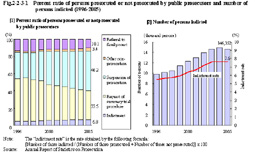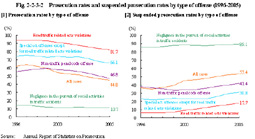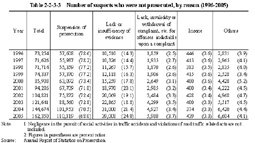| Previous Next Index Image Index Year Selection | |
|
|
Prosecution by public prosecutors includes indictment and request for summary trial procedure. Reasons for non-prosecution dispositions include (1) insufficient conditions for prosecution (for example, lack or withdrawal of a complaint in the case of offenses indictable upon a complaint), (2) the case not being considered an offense (for example, because the suspect is insane), (3) no suspicion of an offense is proved (lack or insufficiency of evidence). In addition, (4) even when the suspicion of an offense is proved, public prosecutors may suspend prosecution if prosecution is deemed to be unnecessary in light of character, age, or circumstances of the suspect, the seriousness and nature of the offense, and the situation after the offense.
Fig. 2-2-3-1 shows the changes in percent ratio of persons prosecuted or not prosecuted and the number of persons indicted in the last ten years. In 2005, the total number of persons finally disposed was 2,139,557. The number of persons indicted was 146,352 (6.8% of the total), those who were prosecuted for summary trial procedure was 716,116 (33.5%), those who were granted suspension of prosecution was 988,473 (46.2%), those not prosecuted for other reasons was 73,028 (3.4%), and those referred to family courts was 215,588 (10.1%). The number of persons indicted increased every year after 1995, but decreased by 2,587 from the previous year in 2005. The indictment rate (the rate of those indicted against the total of those prosecuted and not prosecuted) was on an upward trend after 1993 but has remained flat since 2003 (See Appendix 2-2). Fig. 2-2-3-1 Percent ratio of persons prosecuted or not prosecuted by public prosecutors and number of persons indicted (1996-2005) Fig. 2-2-3-2 shows the trend in prosecution rate and the trend in suspended prosecution rate over the last ten years by type of offense (See Appendix 2-3).Fig. 2-2-3-2 Prosecution rates and suspended prosecution rates by type of offense (1996-2005) Table 2-2-3-3 shows the number of suspects who were not prosecuted for offenses excluding negligence in the pursuit of social activities in traffic accidents and violations of road traffic related acts, by reason for non-prosecution over the last ten years.Table 2-2-3-3 Number of suspects who were not prosecuted, by reason (1996-2005) |


